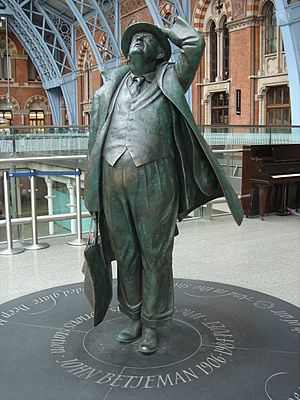Statue of John Betjeman facts for kids
Quick facts for kids Statue of John Betjeman |
|
|---|---|
 |
|
| Artist | Martin Jennings |
| Completion date | 2007 |
| Type | Sculpture |
| Medium | Bronze |
| Subject | John Betjeman |
| Dimensions | 2.10 m (6.9 ft) |
| Location | St Pancras railway station, London |
| 51°31′49″N 0°07′32″W / 51.530278°N 0.125556°W | |
The statue of John Betjeman is located at St Pancras railway station in London. This bronze statue was created by the sculptor Martin Jennings. It was made and cast in 2007.
The statue was officially revealed on November 12, 2007. Betjeman's daughter, Candida Lycett Green, and the Poet Laureate at the time, Andrew Motion, were there. The statue celebrates John Betjeman. It also marked the opening of St Pancras International. This station is the London stop for the Eurostar high-speed rail link. This train connects Great Britain with mainland Europe. The statue's location honors Betjeman's strong connection to St Pancras station. He was a big supporter of Victorian architecture throughout his life.
Contents
Why This Statue?
Who Was John Betjeman?
John Betjeman (1906–1984) was a famous poet. He was also an early champion of Victorian buildings. He helped start the Victorian Society in 1957. At that time, many people didn't like Victorian architecture. Critics often called these buildings ugly.
For example, the writer P. G. Wodehouse joked about it in his 1933 novel, Summer Moonshine. He said Victorians weren't good with building materials. In 1961, the British Railways company destroyed the Euston Arch. This was a grand entrance to Euston Station. This event showed how hard it was to save old buildings.
In the mid-1960s, British Railways planned to tear down St Pancras Station. They also wanted to demolish the Midland Hotel next to it. King's Cross station was also at risk. As a leader of the Victorian Society, Betjeman fought to save St Pancras. In 1966, he asked John Summerson, a famous architectural historian, for help. Summerson first thought the building was not great. But he later changed his mind. His support was key in getting the station and hotel protected. In 1967, they were given Grade I listed building status. This meant they were very important and could not be destroyed.
The Architect: George Gilbert Scott
George Gilbert Scott (1811–1878) was a very important architect. When he died, he was buried in Westminster Abbey. This showed how respected he was. He designed many churches, cathedrals, and public buildings. His company was the biggest architectural firm in Victorian England.
Some of his best works include the Albert Memorial and the Foreign Office. He also designed the Midland Hotel at St Pancras. However, his reputation started to decline even before he died. William Morris strongly criticized Scott's plans to change Tewkesbury Abbey. This led to the creation of the Society for the Protection of Ancient Buildings. By the time Betjeman fought to save St Pancras, Scott's work was not highly valued.
St Pancras Station's Story
For much of the 20th century, St Pancras Station was not well-liked. But in the 21st century, it was beautifully restored. This project cost millions of pounds. Today, it is much admired. Simon Bradley called it "this greatest of High Victorian secular buildings." Historic England even suggests it might be "Britain's most impressive station." Some say only Liverpool Street station rivals it as "the largest and handsomest railway-station in England."
About the Statue
The statue of John Betjeman was created by sculptor Martin Jennings. It is made of bronze and is larger than a real person. It was cast at Pangolin Editions in Gloucestershire. The statue shows Betjeman wearing a suit, a rain coat, and a trilby hat. It captures his slightly messy look. One shoelace is untied, and his collar is scruffy.
The poet is holding his hat and looking up at the station's roof. The statue is 2.10 meters (about 6.9 feet) tall. It stands on a base made of Cumbrian slate. Words from Betjeman's poems are carved into the base. The main words say: "And in the shadowless unclouded glare, Deep blue above us fades to whiteness where, A misty sealine meets the wash of air. / John Betjeman, 1906 – 1984, poet, who saved this glorious station". The statue was unveiled on November 12, 2007. His daughter, Candida Lycett Green, and Poet Laureate Andrew Motion were present.

